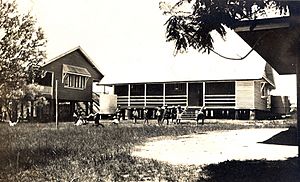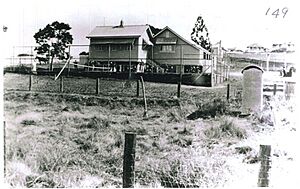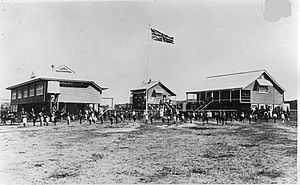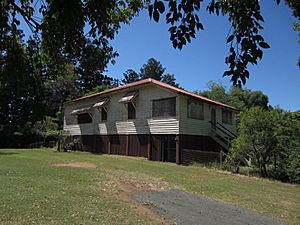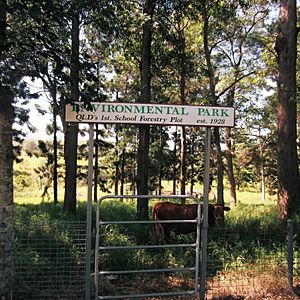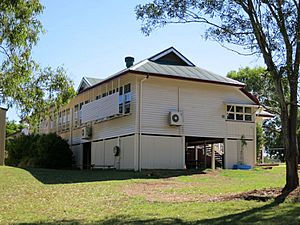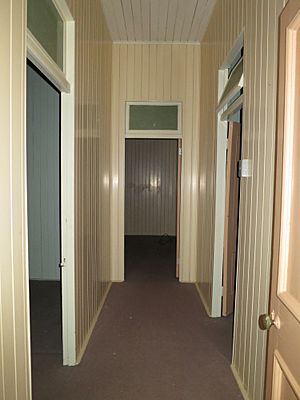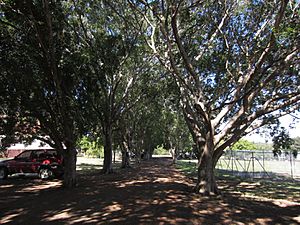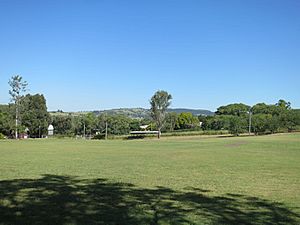Marburg State School facts for kids
Quick facts for kids Marburg State School |
|
|---|---|
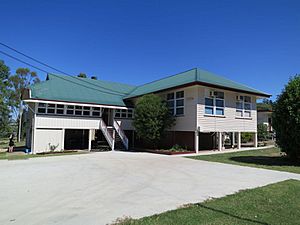
Sectional School Building (Block A), from North, 2015
|
|
| Location | Louisa Street, Marburg, City of Ipswich, Queensland, Australia |
| Design period | 1919–1930s (Interwar period) |
| Built | 1922, 1925, 1926, 1928 |
| Architect | Queensland Department of Public Works |
| Official name: Marburg State School; Marburg Rural School | |
| Type | state heritage |
| Designated | 9 October 2015 |
| Reference no. | 650002 |
| Type | Education, research, scientific facility: School-state; Education, research, scientific facility: Teacher's residence; Parks/gardens/trees: Garden-experimental/research; Parks/gardens/trees: Tree groups |
| Theme | Exploiting, utilising and transforming the land: Managing flora and fauna; Educating Queenslanders: Providing primary schooling |
| Lua error in Module:Location_map at line 420: attempt to index field 'wikibase' (a nil value). | |
Marburg State School is a special old school in Marburg, Queensland, Australia. It's listed on the Queensland Heritage Register because of its history and unique buildings. The school was designed by the Queensland Department of Public Works and first built in 1922. It was also known as Marburg Rural School for a time.
Contents
History of Marburg State School
How the School Started
Marburg State School first opened its doors on March 18, 1879. Back then, it was called Frederick State School. It was built in a small farming area to teach the children of families living there. In 1888, the town's name changed to Marburg, and so did the school's name.
In February 1920, a new part of the school, called Marburg Rural School, began. It taught special subjects for country life. Both the primary school and the rural school moved to their current location in June 1922. The school has been open ever since, serving as an important place for the local community.
Why Schools Were Important
In the early days of Queensland, having schools was very important for communities to grow. People often helped build schools by donating land or their time. Schools became a symbol of progress and a source of pride. They were places where people made lasting connections.
The Queensland Government created standard plans for school buildings. Most schools were made of timber, which was affordable and easy to build, even in faraway places. These designs were updated over time to make sure schools had good air flow, lighting, and were comfortable for students.
Growing with the Town
During the 1880s, Marburg became a busy town for farming and local government. The school grew too, with new parts added and repairs made. In 1911, a railway line reached Marburg, connecting it to bigger towns like Ipswich and Brisbane. This was great for the town, but the railway station took up some of the school's land.
The Rural School Idea
In the early 1900s, there was an idea to teach country children practical skills. This led to the creation of "rural schools." These schools aimed to help students learn about farming and home skills. The goal was to encourage young people to stay and work in rural areas.
John Douglas Story, who was in charge of public education, believed that farming was key to Queensland's future. He helped create a plan for agricultural education. In 1917, the first rural school opened in Nambour.
Marburg Becomes a Rural School
Because the Nambour Rural School was successful, three more rural schools were planned for 1920, and Marburg was one of them. A new, larger piece of land was bought for the school in Louisa Street. This new site was close to the railway station, which was important. Students from nearby towns could travel by train for free to attend the rural school one day a week.
Rural school classes first took place in rented buildings. Then, in 1922, the old school buildings were moved to the new site and used for special vocational classes. Rural schools taught subjects like farming, leatherwork, blacksmithing, and domestic science. They also had clubs for calves, forestry, and growing fruit trees.
New Buildings and Grounds
The main school building, called the sectional school building, was finished in 1922. It was a long, timber building raised on tall stumps. It had a special roof and large windows. Inside, it had five classrooms and a science room.
The school grounds were designed by William Ernest Bick, a famous landscaper from the Brisbane Botanic Gardens. He planned the layout, including areas for trees and gardens. In 1925, a horse paddock was fenced off, and shade trees were planted.
The Teacher's Residence
Most Queensland state schools, especially in the countryside, had a house for the teacher on the school grounds. This was to help attract teachers to rural areas and provide someone to look after the school. A new teacher's house was built at Marburg Rural School in 1926. It was a well-built timber house with several rooms and a verandah.
Queensland's First School Forestry Plot
Marburg State School has a special forestry plot in its north-east corner. This plot, started in 1928, was the very first one in Queensland! School forestry plots taught students about the importance of trees for the environment and the economy. They also helped test different tree types in various soils and climates. The school could even earn money by selling timber from the plot.
Trees planted here included Bunya Pine, Kauri Pine, and Silky Oak. By 1953, about 380 schools in Queensland had forestry projects.
Changes Over Time
The rural school program slowly ended between the 1940s and 1960s. This was because farms became larger, and vocational subjects moved to high schools. Marburg Rural School became a regular state school again in 1963.
Over the years, the school buildings have been updated. In 1959, the main school building got better lighting. The teacher's house also had some small changes, like enclosed verandahs. A new toilet block was added in 1966.
The school has celebrated many milestones, including its 75th, 100th, and 125th anniversaries. In 2009, a new multi-purpose hall was built.
Today, Marburg State School continues to operate from its 1922 site. It still has its original school building, teacher's residence, forestry plot, and horse paddock. The school remains a central part of the Marburg community, educating generations of students and hosting many social events.
Marburg State School Buildings
The Main School Building (Block A)
The main school building, built in 1922, is a timber building raised high off the ground. It has a special roof and is covered in timber boards. It has a verandah on one side, which is now enclosed. Inside, it has four classrooms, though it originally had five. The ceilings are made of timber boards. Underneath the building, there's a shaded play area and storage rooms.
The Teacher's House
The teacher's house, built in 1926, is still very much like it was when it was new. It's also a timber building, raised high on concrete stumps, with a hipped roof. It has bedrooms, a living room, and a kitchen. Many of its original timber doors and windows are still there. The walls and ceilings inside are lined with timber boards.
School Grounds and Views
The school grounds are well-designed and beautiful. The school is on a slope, offering nice views of the countryside. The main driveway has a line of old fig trees, which makes the entrance very welcoming.
North of the teacher's house, you'll find the forestry plot. It has different types of pine trees planted in rows. There's a sign at the entrance that says, "Environmental Park; QLD's 1st School Forestry Plot; est. 1928."
In the north-western part of the grounds is the horse paddock. It's a fenced, grassy area with shade trees.
Other modern structures like sheds, play equipment, and the multi-purpose hall are not part of the heritage listing.
Why Marburg State School is Special
Marburg State School is important for several reasons:
- It shows how state education and school buildings have changed in Queensland over time.
- It has good examples of standard government designs, like the main school building and the teacher's house.
- It's a great example of a rural school, which taught practical skills to country students.
- Its forestry plot was the first of its kind in Queensland, showing how important trees were for the future.
- The school grounds were designed by a famous landscaper, William Ernest Bick, making them very beautiful.
- The school has a strong connection to the Marburg community. It has educated generations of children and is a key place for social events and gatherings.


